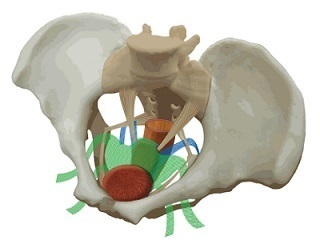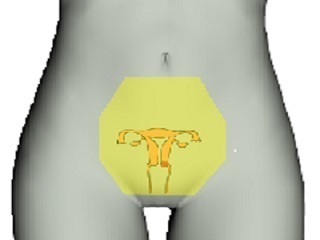 The Importance of Sacrum in Women
The Importance of Sacrum in Women
The Importance of Sacrum to Women Uterus and Ovaries
Because female pelvis is shaped for pregnancy and childbirth, there is a slight loosening and tightening of sacroiliac joints (opening ⇔ closing) in accordance with the menstrual cycle.
Although sacroiliac joint is less than a millimeter of movement, any distortion of three or more of the four points of it (top, bottom, left and right) will have a negative effect.
Furthermore, women experience severe menstrual pain or long-term menstrual irregularities have instability in sacroiliac joint, and the burden on female organ may have accumulated over several years or decades.
・The relationship between menstrual cycle and sacroiliac joint
The average menstrual cycle is a 28-day cycle, and the duration of bleeding is 3 to 5 days(*).
Using the average menstrual cycle as a standard, check for changes in the progress of S.O.T.
*Based on a survey of women in their teens to 40s.
・Perspectives on Pregnancy and Childbirt
Female organs (uterus & ovaries), which play a role in pregnancy and childbirth, and pelvis are closely dependent on each other, and sacrum, located in the center of pelvis, is a structure that is affected by female hormones.
Quadrupeds, such as dogs and cats, can use four legs, large ribs and abdominal muscles to support the increased weight of uterus due to pregnancy.
In contrast, the bipedal human female has to support the weight of fetus vertically, which increases the specific gravity of pelvis. Pelvis is sturdily protected by large surfaces bone and strong tendons, which makes childbirth risky.
In order to widen birth canal as much as possible, female pelvis has evolved a gentle curve in the shape of sacrum, and sacroiliac joint is relaxed to the maximum extent by the action of female hormones.
From the above, the fact that sacroiliac joint does not move as supposed due to the influence of female hormones, or that the movement is imbalanced, is a major problem for women who are pregnant and give birth.
Therefore, the imbalance of sacroiliac joint generates unforeseen stress on the female organs in pelvis.
・Perspectives on Menopause
Although the average age at which menstruation stops is in the late 40s to early 50s, menopause does not mean that the role of uterus and ovaries ends.
They continue to play a lifelong role in regulating the balance of female hormones and lymphatic circulation.
The main cause of menopause is the decline in female hormones. In addition to this, the mental shock of "deeply recognizing that one was aged as a woman" combines to manifest the symptoms.
By adjusting sacrum, the function of uterus and ovaries will not be restored, but it can reduce the burden on female organs and relieve the shock of it.
・The function of female hormones
If sacrum (sacroiliac joint) is distorted and uterus and ovaries are burdened, there is a risk that the secretion of female hormones may not be stable.
For example, symptoms similar to menopause may begin in your 20s or 30s.
<Function of estrogen>
- Feminization (start of the sexual cycle)
- Keeps hair shiny and skin moisturized
- Deposition of subcutaneous fat (breasts, buttocks, thighs)
- Pelvic expansion
- Strengthening of bones, etc.
<Function of progesterone>
- Establishes sexual cycle
- Maintenance of pregnancy
- Breast development and secretion during pregnancy, etc.
・Menstrual Cycle and Female Hormones
・Menstrual Cycle and Female Hormones
During 40 years between menarche and the late 40's to early 50's, a woman ovulates about 400 follicles(*) that mature into an egg each month.
Ovulation, which is very important for women, is deeply related to the secretion and concentration of female hormones.
In the first half of menstrual cycle (days 1-14: before ovulation), a large amount of estrogen is secreted to grow follicle toward ovulation, and after 7 days, luteinizing hormone rises rapidly.
In the second half of menstrual cycle (days 15 to 28: after ovulation), progesterone is secreted to maintain thickened endometrium in preparation for pregnancy. Luteinizing hormone, which rises sharply during the ovulation period, drops rapidly within a few days after ovulation.
*About 400 follicles
When a woman is born, she has about 2 million follicles.
The number of follicles decreases with age, and by the time menarche occurs, the number of follicles has decreased to about 400,000. About 400 of these follicles (0.0002%) develop into eggs.
In lifetime, you will have about 400 chances to get pregnant; if you are 30 years old, you will have about 220 chances left, and if you are 40 years old, you will have about 80 chances (based on the assumption that your first menstruation is at 15 age).

Uterus and ovaries in pelvis

Female genitals over sacrum

The lower part of pelvis is only about 10cm wide at its widest point, and fetus cannot pass through it as it is.
Therefore, from the beginning of pregnancy, hormones are secreted to loosen pelvic ligaments while gradually acclimating body.
This secretion allows pelvis to open at the time of delivery and fetus to be born through birth canal.
The loosening action temporarily opens sacroiliac joint, but after delivery, pelvis gradually loosens up and returns to its.
However, if sacrum is originally misaligned, it may not be able to fully exert its power.
